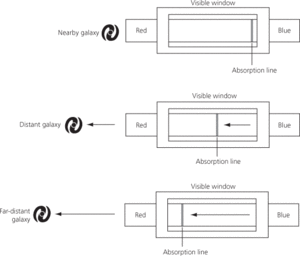1. (Doppler redshift) A displacement of the lines in the spectra of certain galaxies towards the red end of the visible spectrum (i.e. towards longer wavelengths). It is usually interpreted as a Doppler effect resulting from the recession of the galaxies along the line of sight (see expansion of the universe). The redshift is usually expressed as Δλ/λ, where Δλ is the shift in wavelength of radiation of wavelength λ. For relatively low velocities of recession this is equivalent to v/c, where v is the relative velocity of recession and c is the speed of light. If very high velocities of recession are involved, a relativistic version of v/c is required (see relativistic speed). The redshift of spectral lines occurs in all regions of the electromagnetic spectrum; ultraviolet can be shifted into the visible region and visible radiation can be shifted into the infrared region.
2. (gravitational redshift or Einstein redshift) A similar displacement of spectral lines towards the red caused not by a Doppler effect but by a high gravitational field. This type of redshift was predicted by Einstein and some astronomers believe that this is the cause of the large redshifts of quasars, which can be as high as 3.35.
The amount by which the wavelength of light from a receding object is lengthened (i.e. moved to the red) by the Doppler shift. Redshift is calculated from the formula
where λ is the original wavelength (as measured in the laboratory) and Δλ the observed change in wavelength. A redshift of 0.1, for example, means that the light has been redshifted by 10% in wavelength, whereas a redshift of 1 means a change of 100% (i.e. a doubling in wavelength). All galaxies at large distances from our own have redshifts resulting from the expansion of the Universe. At redshifts less than about 0.1, z is related to the apparent velocity of the object, v, by the simple expression z = v/c, where c is the velocity of light. At larger redshifts, this relationship is no longer true, and it is better to think of the redshift as being caused by the expansion of space rather than a Doppler shift. While light is on its way to us from a distant object the Universe is expanding, and this expansion ‘stretches’ the wavelength of the light. For example, when the light left a galaxy with a redshift of 1 the Universe was only half its present size; during the time taken for the light to travel from the galaxy to our telescopes the Universe has doubled in size, causing the wavelength of the light to increase by the same factor.
A galaxy’s redshift can be measured quite easily from its spectrum, unlike its distance, which is very hard to measure directly. At small redshifts, astronomers can calculate the velocity of the galaxy from its redshift and then use Hubble’s law, which relates velocity and distance, to estimate the distance of the galaxy. At larger redshifts, the expansion of the Universe means that distance becomes an ambiguous quantity, but astronomers can use a galaxy’s redshift to estimate the age of the Universe at the time the light was emitted, which is the most important method they have for investigating the history of the Universe (see galaxy evolution). The largest redshifts currently known are around 11, meaning that the light has been shifted in wavelength by 1100% so that ultraviolet lines appear in the red part of the spectrum. See also gravitational redshift; Redshift Survey.
redshift:

Light from receding galaxies is lengthened in wavelength (i.e. shifted to the red), as indicated by the position of absorption lines in their spectra. Redshift is shown here in relation to the visible window of wavelengths to which the eye is sensitive. The more distant the galaxy, the faster its motion away from us, and hence the greater its redshift.
http://www.astro.ucla.edu/~wright/CosmoCalc.html Online calculator for converting redshift to lookback time and other parameters.
The lengthening of the wavelengths of light from an object as a result of the object's motion away from us. It is an example of the Doppler effect. The redshift in light from galaxies is evidence that the Universe is expanding.
Lengthening of wavelengths causes the light to move or shift towards the red end of the spectrum, hence the name. The amount of redshift can be measured by the displacement of lines in an object's spectrum. By measuring the amount of redshift in light from stars and galaxies, astronomers can tell how quickly these objects are moving away from us. A strong gravitational field can also produce a redshift in light; this is termed gravitational redshift.